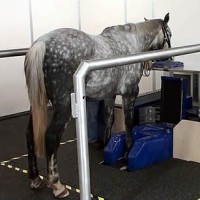UK Veterinarians Present Way to Identify Horses That Should Rest, Not Race
October 15, 2012 — Veterinary experts gathered in Chicago to consider how standing MRI can help diagnose and prevent potentially catastrophic injuries in racehorses. It’s a subject of keen interest in the United States racing industry, which has been under fire in recent months by mainstream media outlets.
The meeting was hosted by Hallmarq Veterinary Imaging, originator of the standing MRI system. As Dr. Dan Brown, business development director for Hallmarq, explained, “The demands of regular training and racing create stress in the bones of racehorses. Some horses respond with increasing strength and speed, others react differently and develop changes which, if undetected, can result in permanent injury, or even fracture, of bones in the fetlock (ankle). As a UK-headquartered company, we’ve worked extensively with UK racehorse veterinarians to establish protocols to accurately identify horses at risk of these injuries, so they may be rested and returned healthy to racing.”
While newspaper headlines focus on the welfare of racehorses that suffer catastrophic fractures on the track, Dr. Sue Stover of UC Davis, CA pointed out that some injuries also cause 20% of affected racehorses in the United States to be removed from training every three months, creating a large economic drain on owners and trainers. Affected horses could also contribute to the percentage of retirees that have lameness issues and therefore are harder to place into new and productive homes.
Dr. Stover, along with Dr. Peter Clegg of Liverpool University in the UK, detailed how the internal structure of the bones of injured horses differs from normal, and how different types of disease progress. Dr. Clegg stated, “The early stages leading to injury should be both detectable by MRI and, if caught early enough, in most cases is fully reversible.”
Pete Ramzan and Sarah Powell from Newmarket, England, then presented their experience establishing protocols in the UK. Dr. Powell explained, “Routine monitoring at training stables by an experienced veterinarian allows horses which are starting to develop bone injury to be identified at an early stage using MRI imaging, accurately distinguishing those at serious risk of fracture from those which can continue to train and race.”
Because anaesthesia is not an option for racehorses in training, Dr. Powell has been using standing MRI since 2006, and having scanned hundreds of cases is now trusted by trainers when she, Dr. Ramzan, and their colleagues at Rossdale and Partners recommend horses either rest or train on, perhaps with a modified training regime.
One year ago, the first of these Hallmarq Expert meetings was held in Saratoga Springs, NY. “It may be some years yet before MRI becomes a routine tool at racetracks in the USA, but Dr. Peloso demonstrated he also sees the same changes that Dr. Powell describes in racetrack fatalities in Florida and all agreed that standing MRI could be a valuable tool in the efforts of veterinarians worldwide to keep racehorses fit and healthy.
For more information about Hallmarq standing MRIs, please visit hallmarq.net, or call 978-266-1219.
About Hallmarq Veterinary Imaging
As the sole global manufacturer of MRI systems for the standing sedated equine and with over 20,000 anesthesia-free exams on record, Hallmarq Veterinary Imaging is the pioneer of safer MRI diagnostics. The team behind its development have decades of experience in the design and manufacture of clinical, research and industrial MRI systems for a range of applications globally. From its beginnings over 10 years ago, Hallmarq’s mission has been to make equine MRI safe, accurate and cost effective for horse owners, and affordable and profitable to key equine veterinary clinics worldwide.
Holly Davis, Horsefly Creative
holly@horseflycreative.com
